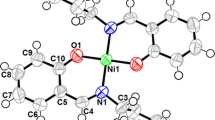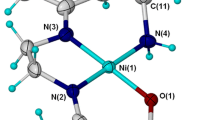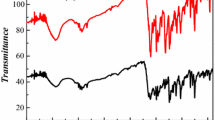Abstract
A polypyridyl nickel complex of [Ni(phen)(H2O)4]SO4⋅2H2O (phen = 1,10-phenanthroline) was synthesized and characterized by X-ray diffraction and IR spectroscopy. The results indicated that the central nickel ion is in a distorted octahedral geometry coordinated by two nitrogen atoms from 1,10-phenanthroline and four water molecules. The crystal data for this complex are: a=8.8797(18) Å, b=18.468(4) Å, c=22.081(4) Å, α=90°, β=90°, γ=90°, R 1=0.0533, and wR 2=0.2095. Electrochemical experiments showed that the complex could be reoxidized at a gold electrode under the precondition of electrolysis stripping. According to the results of cyclic voltammetry and coulometry, an electrochemical reaction mechanism was proposed. The DNA binding properties of the complex were further investigated by electronic absorption spectrophotometry and electrochemistry. The binding constant and the binding mode between the two species were estimated based on the spectroscopic and electrochemical results.
Similar content being viewed by others
References
Yamanaka, T.: In: Otsuka, S., Yamanaka, T. (eds.) Metalloproteins, p. 285. Elsevier, Amsterdam (1998)
Matkar, S.S., Wrischnik, L.A., Jones, P.R., Hellmann-Blumberg, U.: Two closely related nickel complexes have different effects on DNA damage and cell viability. Biochem. Biophys. Res. Commun. 343, 754–761 (2006)
Kawanishi, S., Inoue, S., Oikawa, S., Yamashita, N., Toyokuni, S., Kawanishi, M., Nishino, K.: Oxidative DNA damage in cultured cells and rat lungs by carcinogenic nickel compounds. Free Radic. Biol. Med. 31, 108–116 (2001)
Volkmer, D., Hommerich, B., Griesar, K., Haase, W., Krebs, B.: Dinuclear nickel(II) complexes as models for the active site of urease. Inorg. Chem. 35, 3792–3803 (1996)
Schäfer, S., Ott, I., Gust, R., Sheldrick, W.S.: Influence of the polypyridyl (pp) ligand size on the DNA binding properties, cytotoxicity and cellular uptake of organoruthenium(II) complexes of the type [(6-C6Me6)Ru(L)(pp)]n+ [L = Cl, n=1; L = (NH2)2CS, n=2]. Euro. J. Inorg. Chem. 3034–3046 (2007)
Song, G.W., Li, L., Liu, L.M., Fang, G.R., Lu, S.F., He, Z.K., Zeng, Y.E.: Fluorometric determination of DNA using a new ruthenium complex Ru(bpy)2PIP(V) as a nucleic acid probe. Anal. Sci. 7, 757–759 (2002)
Scharwitz, M., Ott, I., Geldmacher, Y., Gust, R., Sheldrick, W.R.: Cytotoxic half-sandwich rhodium(III) complexes: Polypyridyl ligand influence on their DNA binding properties and cellular uptake. J. Organomet. Chem. 693, 2299–2309 (2008)
Wang, Q.X., Jiao, K., Sun, W., Jian, F.F., Hu, X.: Binding of an oxo-bridged dinuclear iron(III) complex{[Fe(phen)(H2O)3]2O}(SO4)2 to DNA and its recognition of single- and double-stranded DNA as determined by electrochemical studies. Eur. J. Inorg. Chem. 1838–1845 (2006)
Millan, K.M., Angela, S., Susan, R.M.: Voltammetric DNA biosensor for cystic fibrosis based on a modified carbon paste electrode. Anal. Chem. 66, 2943–2948 (1994)
Reichman, M.E., Rice, S.A., Thomas, C.A., Doty, P.A.: A further examination of the molecular weight and size of desoxypentose nucleic acid. J. Am. Chem. Soc. 76, 3047–3053 (1954)
Kumar, C.V., Asuncion, E.H.: DNA binding studies and site selective fluorescence sensitization of an anthryl probe. J. Am. Chem. Soc. 115, 8547–8553 (1993)
Sheldrick, G.M.: SADABS, Program for Empirical Absorption Correction of Area Detector Data. University of Gottingen, Gottingen (1996)
Sheldrick, G.M.: SHELXS-97, program for x-ray crystal structure solution. University of Gottingen, Gottingen (1997)
Cromer, D.T., Waber, J.T.: International Tables tor X-Ray Crystallography. Kynock Press, Birmingham (1974)
Walczak, M.M., Flynn, N.T.: Spectroelectrochemical study of the generation of tris-(1,10-phenanthroline) iron(II/III) from m-oxo-bis[aquabis(1,10-phenanthroline) iron(III). J. Electroanal. Chem. 441, 43–49 (1998)
Bard, A.J., Faulkner, L.R.: Electrochemical Methods: Fundamentals and Applications. Wiley, New York (1980)
Henne, B.J., Bartak, D.E.: Metal-vapor synthesis and electrochemistry of bis(bipyridyl)nickel(0). Inorg. Chem. 23, 369–373 (1984)
Wang, Q.X., Jiao, K., Liu, F.Q., Yuan, X.L., Sun, W.: Spectroscopic, viscositic and electrochemical studies of DNA interaction with a novel mixed-ligand complex of nickel (II) that incorporates 1-methylimidazole and thiocyanate groups. J. Biochem. Biophys. Methods 70, 427–433 (2007)
Jiao, K., Wang, Q.X., Sun, W., Jian, F.F.: Synthesis, characterization and DNA-binding properties of a new cobalt(II) complex: Co(bbt)2Cl2. J. Inorg. Biochem. 99, 1369–1375 (2005)
Tang, S.P., Hou, L., Mao, Z.W., Ji, L.N.: Synthesis, crystal structures, DNA binding and oxidative cleavage studies of copper(II) complexes of N2S2 tetradentate ligands. Polyhedron 28, 586–592 (2009)
Zhang, Q.L., Liu, J.G., Chao, H., Xue, G.Q., Ji, L.N.: DNA-binding and photocleavage studies of cobalt(III) polypyridyl complexes: [Co(phen)2IP]3+ and [Co(phen)2PIP]3+. J. Inorg. Biochem. 83, 49–55 (2001)
Navarro, M., Cisneros-Fajardo, E.J., Sierralta, A., Fernández-Mestre, M., Silva, P., Arrieche, D., Marchán, E.: Design of copper DNA intercalators with leishmanicidal activity. J. Biol. Inorg. Chem. 8, 401–408 (2003)
Pasternack, R.F., Gibbs, E.J., Villafranca, J.J.: Interactions of porphyrins with nucleic acids. Biochemistry 22, 2406–2414 (1983)
Scharwitz, M.A., Ott, I., Geldmacher, Y., Gust, R., Sheldrick, W.S.: Otoxic half-sandwich rhodium(III) complexes: polypyridyl ligand influence on their DNA binding properties and cellular uptake. J. Organomet. Chem. 693, 2299–2309 (2008)
Jing, B.W., Zhang, M.H., Shen, T.: [Ruthenium(II)(bpy)2L]2+, where L are imidazo[f]-1,10-phenanthrolines: synthesis, photophysics and binding with DNA. Spectrochim. Acta. A 60, 2635–2641 (2004)
Sherman, S.E., Gibson, D., Wang, A.H.J., Lippard, S.J.: Crystal and molecular structure of cis-[Pt(NH3)2[d(pGpG)]], the principal adduct formed by cis-diamminedichloroplatinum(II) with DNA. J. Am. Chem. Soc. 110, 7368–7381 (1988)
Zhou, J.Y., Li, Q.X., Wang, L.J., Liao, Z.R., Xu, H.B.: DNA damage by copper(II) complexes: coordination-structural dependence of reactivities. J. Inorg. Biochem. 75, 233–240 (1999)
Wolfe, A., Shimer-Jr, G.H., Meehan, T.: Polycyclic aromatichydrocarbons physically intercalate into duplex regions of denatured DNA. Biochemistry 26, 6392–6396 (1987)
Wu, J.Z., Zhou, Z.Y., Ji, L.N.: Structure of [Ru(phen)3](ClO4)2⋅(C2H5)2O. Cryst. Res. Technol. 36, 101–105 (2001)
Mudasir, Yoshioka, N., Inoue, H.: DNA binding of iron(II) mixed-ligand complexes containing 1,10-phenanthroline and 4,7-diphenyl-1,10-phenanthroline. J. Inorg. Biochem. 77, 239–247 (1999)
Mello, L.D., Pereira, R.M.S., Sawaya, A.C.H.F., Eberlin, M.N., Kubot, L.T.: Electrochemical and spectroscopic characterization of the interaction between DNA and Cu(II)–naringin complex. J. Pharm. Biomed. 45, 706–713 (2007)
Zhang, Y.Z., Cai, Y.J., Su, S., Ni, Y.H.: Electrochemical studies of oxidation of lomefloxacin and interaction with calf thymus DNA at nano-SnO2/DHP modified electrode. Electroanal. 18, 1479–1484 (2006)
Arjmand, F., Mohani, B., Parveen, S.: New dihydro O,O′-bis(salicylidene) 2,2′ aminobenzothiazolyl borate complexes: kinetic and voltammetric studies of dimethyltin copper complex with guanine, adenine, and calf thymus DNA. Bioinorg. Chem. Appl. 2006, 1–10 (2006)
Xu, Z.H., Chen, F.J., Xia, P.X., Liu, X.H., Zeng, Z.Z.: Synthesis, characterization, and DNA-binding properties of the cobalt(II) and nickel(II) complexes with salicylaldehyde 2-phenylquinoline-4-carboylhydrazone. J. Photochem. Photobiol. Chem. 196, 77–83 (2008)
Laviron, E.: : General expression of the linear potential sweep voltammogram in the case of diffusionless electrochemical systems. J. Electroanal. Chem. 101, 19–28 (1979)
Author information
Authors and Affiliations
Corresponding author
Rights and permissions
About this article
Cite this article
Wang, Q., Guo, H., Li, S. et al. Synthesis, Electrochemical Characteristics of [Ni(phen)(H2O)4]SO4⋅2H2O and Its Interaction Mechanism with DNA. J Solution Chem 38, 1085–1095 (2009). https://doi.org/10.1007/s10953-009-9425-0
Received:
Accepted:
Published:
Issue Date:
DOI: https://doi.org/10.1007/s10953-009-9425-0




